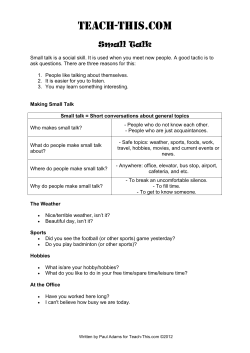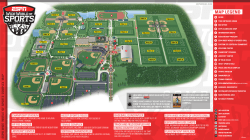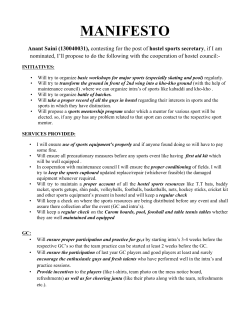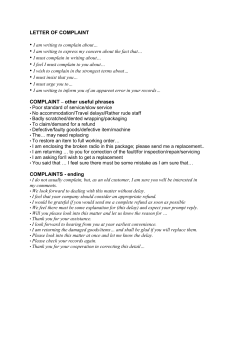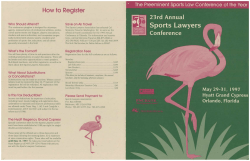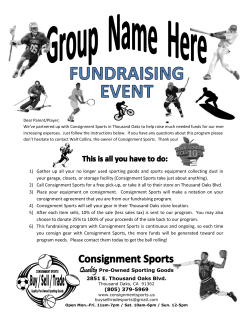
U.S. Culture Series: American Sports Scott Manley
U.S. Culture Series: American Sports Scott Manley Sports in the U.S. Sports in the U.S. are an important part of the culture. The sporting culture is different from that of other countries, with a unique set of sports being popular. Sports are organized differently: No system of promotion/relegation. Playoff system after the regular season. School and college competitions are important. Competition between national teams is far less important. Importance of Sports in the U.S. Sports play an important role in American society, beyond their popularity. They are vehicles for transmitting values such as fair play, justice, and teamwork. They have contributed to the racial and social integration, and act as a “social glue”that helps bind society together (Jackie Robinson). Team Sports: The Big Four Baseball Basketball Football Hockey University of Michigan Sports The Wolverines comprise 25 varsity sports. 10 of the past 14 years, UM finished in the top five of the NACDA Director’s Cup which charts the overall success (in top 10 in 14 of 16 seasons). One of two schools to win national championship in the four main men’s sports: football (11), baseball (2), basketball (1), and hockey (9)*. Also won championships in: women’s field hockey (1) and softball (1) and men’s golf (2), gymnastics (3), swimming and diving (11), tennis (1), and outdoor track and field (1). Football is the most successful in college history: 877 games and .741 winning percentage. Michigan Stadium is the largest football stadium in the world (106,201, with biggest of 112,118). Tailgating is a tradition, as it is at most football games. Baseball Oldest of American team sports: MLB is from 1869. Remained the most popular until the 1960s. Still referred to as “America’s pastime.” Major League Baseball Now considered to be the second most popular professional league. Still leader in ticket sales, due to high number of games in the season. 30 teams in two leagues: American (14 teams) and National (16 teams). National League from 1876, American from 1901. Recently, PEDs have become the main topic of concern. World Baseball Classic Created by MLB and other professional leagues. Sanctioned by International Baseball Federation as one of two major world championship (along with the Summer Olympics, but baseball is no longer an Olympic sport). Japan won the first two championships (Matsuzaka was MVP both times). Most Americans don’t care for it because they think the players won’t play as well for their MLB teams. Basketball Invented in Massachusetts, by Canadian James Naismith. Considered 2nd most popular sport overall when including amateur levels. College basketball is more popular that professional basketball in many areas of the U.S. More Americans play basketball than any other team sport. National Basketball Association 3rd most popular professional league. 30 teams in two conferences (Eastern and Western). Increasing number of international players helping the league gain popularity worldwide. March Madness Single elimination tournament of 65 top college teams organized by the NCAA. Determined by a selection committee, 30 automatically admitted, 35 at-large bids. Affects workplace productivity, some estimates project U.S. companies will lose up to $3.5 billion this month. One of the major events for gambling (office pools and brackets). Football Most popular sport in the U.S. at every level: high school college professional The most television viewers too. National Football League Preeminent professional sports league in the U.S. 32 teams divided equally between two conferences. 16 game regular season. 12 team playoffs that culminate in a championship game. The Super Bowl The Championship Game of the NFL. Biggest annual sporting event in the U.S. Almost as famous now for the commercials as it is for football. 30 seconds in 2010 cost $3.01 million College Bowl Games Four major bowl games rotate the championship game the BCS National Championship Game. The more prestigious the bowl game, the more money the school receives. Conferences commit to sending representatives to specific bowl games. Controversial because the two topranked teams play for the championship, but might not be the two best teams (politics, multiple teams with no losses, etc.). Hockey Always been a mainstay of the culture in the Great Lakes, Mid-Atlantic, and New England areas. Becoming increasingly popular as ice rinks are built in the southern and western states. Some of the most famous U.S. sporting events have been in hockey, the “Miracle on Ice.” National Hockey League 30 teams, with six located in Canada. Divided between the Eastern and Western Conferences. Very internationalized with players from 18 different countries. Talk of expansion in Europe. Stanley Cup is reused each year. Smallest fan base and revenue of the 4 major sports. Soccer Is slowly gaining in popularity; it is the #1 youth participation sport today. Men’s national team has steadily improved due to this, and the women’s is one of the world’s premier sides. Major League Soccer is popular, but most don’t view it is a premier league and will follow the main European leagues, such as the Premier League in the U.K. Less Popular Team Sports Lacrosse Rugby Volleyball Cricket Curling Individual Sports Golf Tennis Motor Sports (NASCAR, Indy Car, Formula One) Boxing Horse Racing Skiing Outdoor Sports (Hunting, Fishing) Mixed Martial Arts Alternative/Extreme Sports (Snowboarding, Skateboarding) Fandom Fan is short for fanatic, and many sports fans are crazy about sports What determines which team you will support? Geography Family School attendance/enrollment Gives a sense of community, camaraderie, and escapism to people. Fantasy Sports Also known as rotisserie or roto. Participants act as owners, build their teams through a draft, and compete against other participants. Scoring is based on the statistics of real players. One participant acts as a league commissioner and sets the rules for the league and solves disputes between participants. Most leagues play for money which is legal under the Unlawful Internet Gambling Enforcement Act of 2006. Sports in the Media Television networks pay millions for the rights to broadcast sporting events. Cable and satellite has greatly expanded coverage (ESPN). U.S. does not have a national daily sports newspaper (difficult to do with the four time zones). Many magazines, even ones about fantasy sports (Sports Illustrated is the most famous). The Internet has turned sports into a 24/7 business. Sports Influence on Language The ball is in your court (tennis). Lead with your chin (boxing). Beat you to the punch (boxing). Lightweight (boxing). Down for the count (boxing). No holds barred (wrestling). Down to the wire (horse racing). Play ball (baseball). Drop the ball (baseball). Run interference (football). The gloves are off (hockey). Saved by the bell (boxing). Hands down (horse racing). Slam dunk (basketball). Hit below the belt, low blow (boxing). Keep your eye on the ball (baseball, tennis). Pull one’s punch (boxing). Throw in the towel (boxing). Win by a nose (horse racing).
© Copyright 2025
